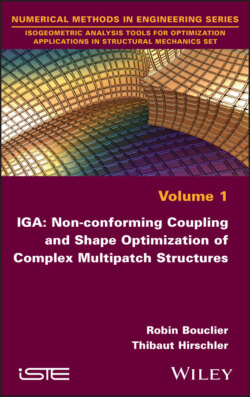Читать книгу IGA - Robin Bouclier - Страница 28
1.4.1. The trimming concept
ОглавлениеTrimming is one of the most fundamental tools in CAD environments, where complex geometries are built using Boolean operations. The process enables us to create an almost unlimited range of geometric shapes. The trimming concept is illustrated in 2D for the simple situation of a circular hole living in a rectangular structure (see Figure 1.16). This surface can be classified as a trimmed surface. Its description is simply given by: a one-patch (linear, 1 element) B-spline surface parameterization for the plate (without the hole) and a (quadratic, four elements) NURBS curve parameterization for the trimming curve that forms the boundary of the hole (see Figure 1.16(a)). In CAD, the trimming curve specifies visible and invisible regions on the surface patch (see Figure 1.16(b)). As a result, the underlying spline patch remains unaffected by the trimming object and preserves its topology. Conversely, using standard IGA for the analysis of such a geometry would require a delicate spline re-parameterization of the whole model, leading to the appearance of C0 lines due to the patch structure of multivariate splines. An example of a boundary-fitted NURBS parameterization of the plate including the hole (i.e. without trimming) is shown in Figure 1.16(c). It is composed of four elements connecting along C0 lines with degree 2 into the circumferential direction and degree 1 into the radial direction. In the case of multiple holes, the situation becomes even trickier since the resulting geometry strongly differs topologically from a square. As a result, it becomes necessary to define different patches around each hole (see Figure 1.16(d) for an illustration with two holes) and to group them together (the same process as assembling finite elements in standard FEM). The new spline models of Figure 1.16(c) and 1.16(d) are commonly referred to as analysis-suitable models in the sense that they can be easily enhanced using classic spline refinement (see section 1.2.3) to compute the solution of a corresponding mechanical problem.
The simple example of a plate with holes in Figure 1.16 underlines the difficulties of generating analysis-suitable models for IGA. From a more general point of view, there are mostly two ways to deal with this issue. First, we can strive to remove all trimmed regions by invoking re-parameterization strategies (as in Figure 1.16(c) and 1.16(d)), which can be cumbersome (Xu et al. 2013; Akhras et al. 2016; Massarwi et al. 2019). The second option consists of developing advanced numerical tools for analyzing models with the mentioned defects coming from the geometric modeling (Marussig and Hughes 2018; Teschemacher et al. 2018). The works presented in this book are heading in the second direction: in particular, trimming will be faced in Chapter 2 for the simulation of local phenomena within IGA models. Let us finally quote that the two approaches are not opposed, and, as already stated, it is by combining the innovations from both the geometrical and analysis sides that researchers and engineers will succeed in the long term.
Figure 1.16. Illustration of the trimming concept on a simple example of a plate with holes. For a color version of this figure, see www.iste.co.uk/bouclier/IGA.zip
